INTRODUCTION
The YHF has become a highly effective humanitarian financing mechanism in Yemen, consistently meeting commitments on localization and using cash when required. It continues to prioritize localization, actively including more Yemeni organizations in its operations through its Localization Strategy and growing pool of partners.
The Fund currently has 84 eligible partners, including 40 NNGOs, which expanded assistance to vulnerable and underserved areas. The YHF has emerged as a primary source of direct funding for Yemeni organizations, with 43% of funding allocated to national frontline responders in 2022, nearly double the previous year's percentage, and 41.33% so far in 2023.
To sustain progress and address humanitarian needs effectively, continued support for the YHF is encouraged, as it is well-positioned to assist the most vulnerable people in Yemen.
OTHER DONORS
THE YHF THANKS OUR DONORS FOR THEIR GENEROUS SUPPORT IN 2022
LEAP IN CHILDREN SCHOOLING WITH SIMPLE AID
Social Development Hodeidah Girls Foundation (SDHGF)
Years of conflict have severely impacted Yemen’s education system. More than 2,700 schools have been destroyed, partially damaged, or utilized for non-educational purposes. Climate-induced weather events exacerbate these challenges, with 370 schools across the country impacted by severe flooding in 2022. An estimated 2.7 million children are out of school, and those who attend face significant challenges due to the lack of resources and facilities. Al Hodeidah Girls Foundation, with support from the Yemen Humanitarian Fund (YHF), intervened in Al Makha District of Ta’iz Governorate to improve the educational situation.
"Now, our classroom has become a comfortable learning environment, thoughts of going home early no longer occupy my mind," said Bakil, a 12-year-old student at Al-Fajr Al-Jadeed School. The addition of new chairs in their classrooms has made a significant difference, allowing them to sit in an orderly manner, see the blackboard clearly, and actively engage with the teacher's explanations.
Previously, the lack of chairs in the classroom had caused great suffering. Students had to sit on the floor, resulting in poor visibility of the blackboard and difficulty in hearing the explanations. The cramped space made it challenging to write neatly in their notebooks. Bakil recalls the situation, stating, "Half of us were sitting on the floor while the others were on unstable chairs."
To alleviate the discomfort, Bakil's father made a makeshift wooden chair for him to bring to school. Although it helped with visibility, the absence of a table made it impossible to write properly. Bakil explains, "I had to balance the notebook on my knees, causing back pain, which hindered my handwriting improvement. "
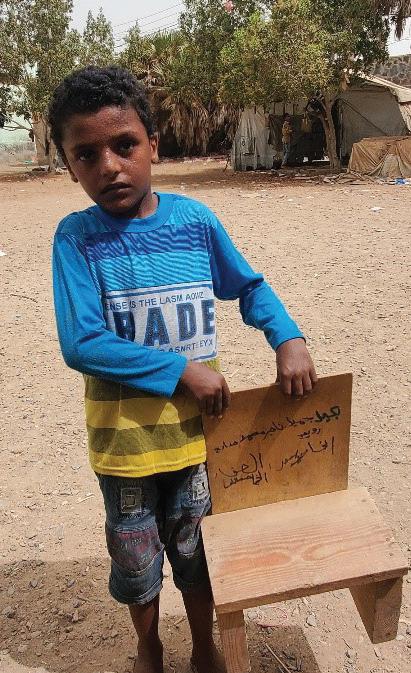
The lack of comfort made Bakil constantly yearn to go home and rest, making it difficult for him to concentrate on studying one or two lessons a day.
Supported by the Yemen Humanitarian Fund (YHF), the Social d evelopment Hodeidah Girls Foundation (S dHGF) supplied 230 school desks to three schools in the Al Makha District of Ta’iz Governorate: Al-Hulaibi, Al-Fajr Al-Jadeed, and Al-Zahraa schools. In addition, the foundation maintained 40 school desks, constructed eight new classrooms, rehabilitated bathrooms, and offered teacher incentives for five months in the schools mentioned-above.
“I am very happy. I felt that I’m really learning and that a beautiful new life had begun in my school journey,” said Bakil, a few weeks after the intervention. Similarly, Ahlam, one of the teachers at Al-Fajr Al-Jadeed School, stated that the new chairs made the classroom quieter and more organized, and the students were more comfortable, which reduced the school dropout rate.
Ahlam adds that the SDHGF’s intervention brought indescribable joy and happiness to the students and teachers, and she hopes that other organizations follow the example in supporting education. The lack of chairs was an obstacle even for the teachers to move between the students and thus impacted the students’
comprehension of the lessons. But now, the educational situation has improved significantly, and their interests have shifted from thinking about providing the minimum level of comfort for students in the classroom to thinking of improving teaching methods and creating interesting educational ways for children.
The educational interventions supported by the Yemen Humanitarian Fund (YHF) have made a significant impact on the education sector in Yemen. More support is needed, so YHF and partners can continue providing support to ensure that all children in Yemen have access to quality education.
IMPROVING WATER ACCESS AND HYGIENE PRACTICES IN CONFLICT-AFFECTED COMMUNITIES
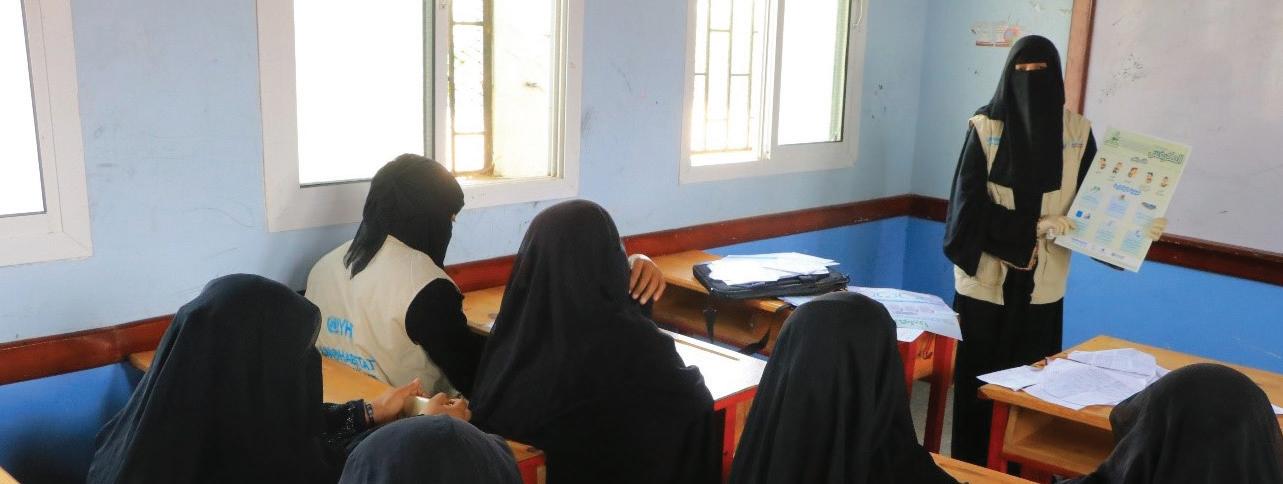
United Nations Human Settlements Programme (UN-HABITAT)
“Al-Tour and At-Taif subdistricts were the conflicts areas, so the main roads connected to them are cut-off most of the time, leaving them unable to get the diesel fuel they use to run pumps that lift water from wells to tanks that distribute water to their villages by gravity. Women and children would wake up early in the morning just to navigate areas with hot weather and to bring water from remote areas by donkeys or on their backs and return on foot. Considering how long it took them to source the water, children often suffer the indignity of having to defecate in the open, which resulted in pollution and also contributed to the spread of diseases.”
When 40-year-old Ali Salem fled his home in Al-Jah, Hodeidah Governorate, northern Yemen four years ago, he expected that he would reach a nearby and safe place for her family of ten, and this safe place has least resources of life, which is water, so the family was displaced to the village, within Al-Tour Subdistrict, where there is a well that contains a diesel pumping system and a large towertank of water sufficient to distribute water to all villages in the Al-Tour Subdistrict. After the family settled, the conflict reached the main roads leading to Al-Tour, which caused them to be unable to obtain diesel, suffer water cuts and a lack of public services, and this caused
the deterioration of the pumping system and the tower tank as well. The family had to fetch water from a well located half an hour away, and water was not always available.
“ due to water scarcity, some members of our community have suffered health issues and the risk of water-borne diseases has increased. It was a hard life,” Ali explains.
The UN-Habitat Project embarked on a mission to provide emergency wASH ( water, Sanitation, and Hygiene) services to the displaced population and hard-to-reach locations in the Ad- durayhimi and Bayt Al Faqih districts. The impetus for this project was to facilitate the living conditions of internally displaced persons (IdPs) and their host communities, who were bearing the brunt of inadequate wASH services.
Funded by YHF, the project saw UN-Habitat and implementing partners rehabilitate eight water sources in the aforementioned districts. This was achieved through the installation of solar-powered pumping systems and a comprehensive network of water pipes, and the creation of water distribution points. water quality and pumping tests were conducted to ensure the efficiency and safety of the new
systems. To ensure the sustainability of these water projects, 24 members from the communities, 16 from Ad durayhimi, and eight from Bayt Al-Faqih, were trained for operation and maintenance.
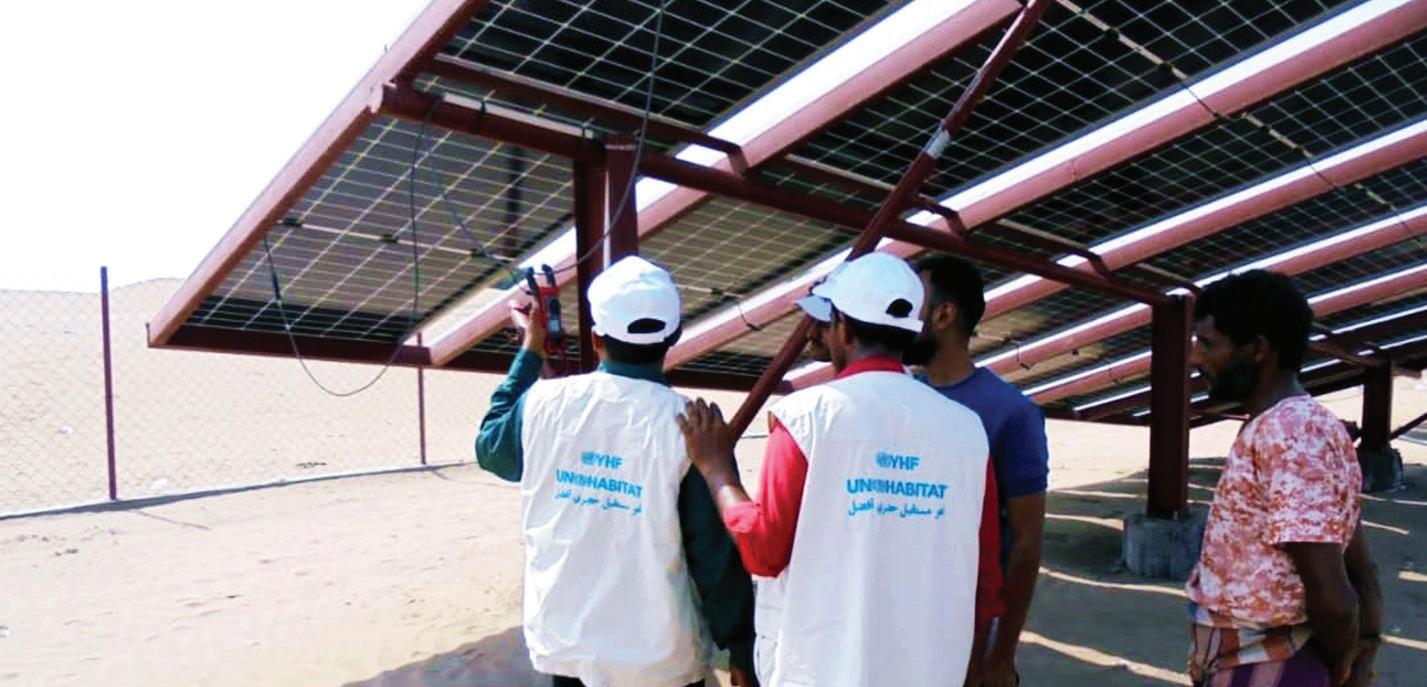
The project also aimed to enhance hygiene practices among IDPs and their host communities. Several hygiene promotion activities were initiated, including training community volunteers (CV), who then reached out to a staggering 6,968 people with crucial messages on hygiene best practices. This was achieved through 1,020 engaging sessions, where informative materials such as posters were distributed.
Furthermore, 40 women from the communities were trained as volunteers, empowering them with skills and knowledge about hygiene practices. They conducted 2,239 sessions, reaching out
to another 10,414 people from the IdPs and host communities and disseminating vital hygiene practices through posters.
While identifying areas with the direst need, the project installed 462 emergency latrines, a significant step towards improved sanitation and hygiene. These latrines have not only facilitated proper waste disposal but also provided much-needed privacy, thus contributing to the overall well-being of the communities.
“Now, with the availability of latrines, water and some of us being trained in the maintenance of the solar pumping system, our community has improved tremendously, people’s privacy has been restored, and our camps are much cleaner,” Ali said.
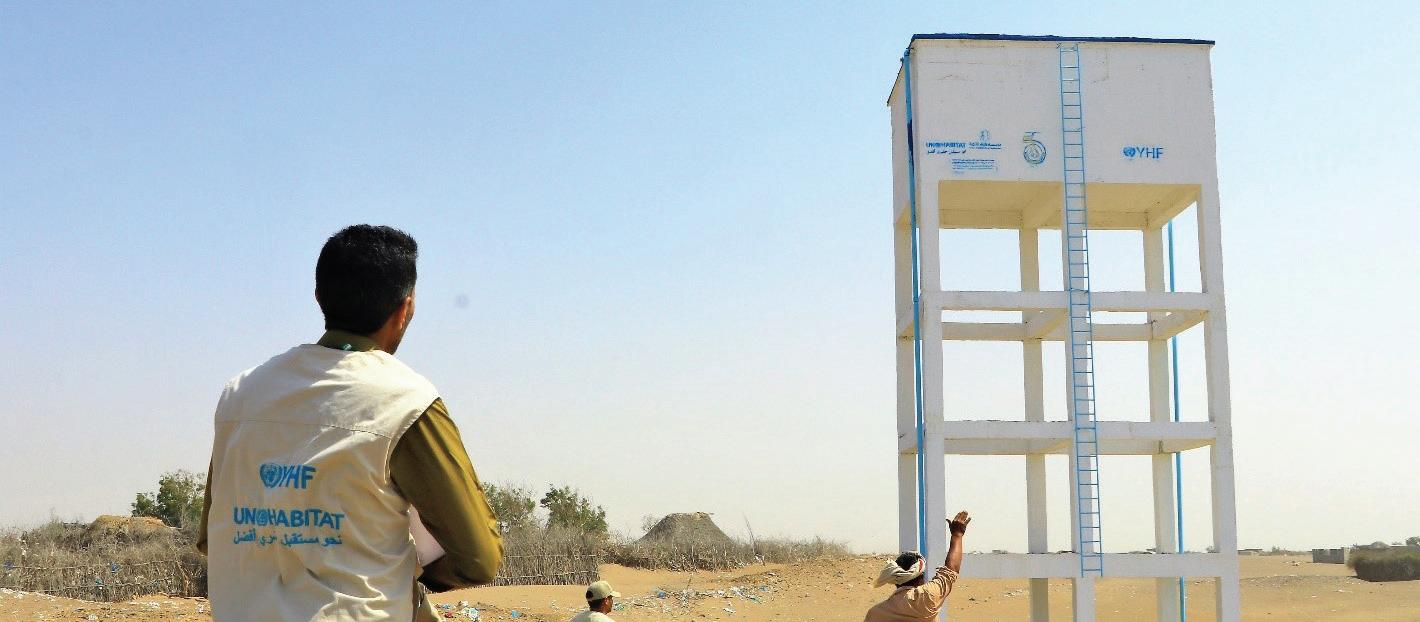
HAIFA’S STORY: HOPEFUL STORY OF RECOVERY FROM ACUTE MALNUTRITION
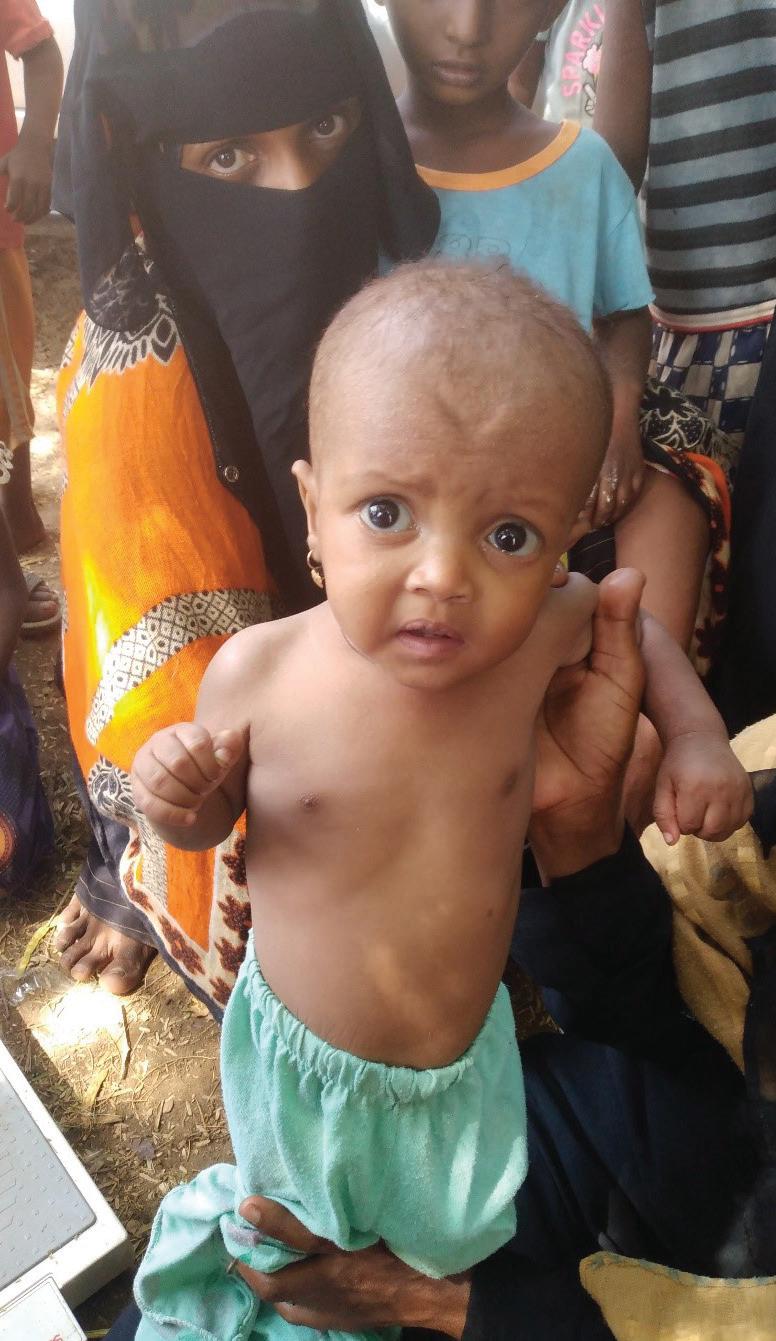
Field Medical Foundation (FMF)
Yemen is currently facing high levels of acute malnutrition among children under the age of 5, with approximately 2.3 million children at risk, according to the Integrated Food Security Phase Classification (IPC) and Acute Malnutrition Report. The country's health system has been severely impacted by the ongoing conflict, making it difficult to address the issue. o nly 50 per cent of health facilities in Yemen are fully functioning.
Thanks to donor contributions, the Yemen Humanitarian Fund (YHF) supported organizations working in the nutrition and health sectors with US d 5 million in 2022.
Through the YHF’s support, the FMF was able to provide an integrated Health, Nutrition, and Communication for d evelopment (C4D) package of essential services to communities in Zinjibar district. The FMF's Mobile Medical Team (MMT) visited IdP camps in Al-Qarw village, where they met Haifa, a 3-month-old child suffering from severe malnutrition complicated by Gastroenteritis. Haifa's family had been forced to flee their village in Ta’iz Governorate due to the conflict. They are living in poor conditions with no source of income.
Thanks to the FMF's efforts, Haifa was given first aid and accompanied to the hospital where she received treatment for her condition. She was admitted to the Therapeutic Feeding Center (TFC) for 7 days before being discharged and transferred to the Outpatient Therapeutic Programme (OTP) of FMF's Mobile Medical Clinic. Haifa was monitored on a weekly basis for over three months and was eventually cured of severe acute malnutrition. She was then enrolled in the Blanket Supplementary Feeding Programme (BSFP) to prevent the recurrence of malnutrition, and her family has received continuous support and guidance on the importance of breastfeeding and the risks of malnutrition on the health of infants.
The Yemen Humanitarian Fund (YHF) has been crucial in supporting the FMF and other organizations’ work in providing essential health and nutrition services to those in need, like Haifa and her family. However, donor support to the YHF is needed to ensure the sustainability of such life-saving activities for millions of people in need in Yemen.
NOTHING FEELS LIKE HOME
Norwegian Refugee Council (NRC)
Ali Maqbool’s, 34-year-old, used to be safe and sound at home, and work without worrying about how tomorrow will be. This was life in his hometown in Harad, north of Yemen.
Ali feels melancholy when he remembers how his life was before May 2015. Ali, his wife, and three daughters now live in the Al-Habeel displacement Site in Abs.
Ali’s family carries heavy memories from their displacement. They had walked from Harad to Al-Khamaj in 2015 under the hot sun.
Barely staying for two years, in 2017, they fled again to Bani Hassan, thinking it would be the last. However, in 2019, the war reached Bani Hassan forcing the family to flee again until they set foot in AlHabeel Site.
The family did not take anything with them during their displacement. And each time, they had to start all over again.

w hen the family reached Al-Habeel Site, the Norwegian Refugee Council (NRC) provided them with a safe shelter, a latrine, blankets, beds, and mats. Then, NrC, with support from the Yemen Humanitarian Fund (YHF), provided them with cash assistance. This has eased the family’s desperate situation. However, for Ali, nothing feels like home.
Many families like Ali's have been displaced several times due to the conflict in Yemen. The Yemen Humanitarian Fund (YHF) and its partners continue to provide critical assistance to help these families survive. But ultimately, they deserve the chance to return home and rebuild their lives. Until then, it is vital that the international community continues to support the Yemen Humanitarian Fund (YHF) to provide much-needed assistance to those affected by the conflict.
FORCED TO FLEE, UNABLE TO RETURN
Danish Refugee Council (DRC)
o ver eight years of ongoing conflict in Yemen have taken a devastating toll on people across the country, forcing over 4.5 million people to leave their homes. Thanks to funding from the Yemen Humanitarian Fund (YHF), the danish Refugee Council (dRC) supports internally displaced people (IdPs) to live safely and with dignity.
Qasim, 65 years old, a husband and father of nine children, never imagined that he would be forced to leave his home in Al Hodeidah, Yemen. His life, like that of many Yemenis, was turned upside down by the conflict that has ravaged the country since 2015. Qasim, his wife, and their nine children fled their home leaving behind all their belongings and ran with only their clothes. “Even my personal Id card, I couldn’t take it,” he said.
After a long and difficult journey to escape the fighting, Qasim and his family reached o m Hurez in l ahj Governorate. However, Qasim continued to face challenges as he tried to build a life in displacement. One of the biggest challenges for Qasim and his family was finding a safe place to live. “Being moved from one place to another isn’t a simple matter. However, I tried to adapt to this area,” he stated. returning to Al Hodeidah was an option he was considering, but not after one of his neighbors returned and died a short time later due to landmine explosion. "The hardest part about being displaced is thinking that going back to your hometown means death,” said Qasim.
Thanks to funding from the Yemen Humanitarian Fund (YHF), the danish Refugee Council (dRC) stepped in to provide support to IdP families in Om Hurez IdP Site. Camp Coordination and Camp Management (CCCM) teams helped with providing shelters, latrines, kitchen utensils and non-food items (NFIs) to IDPs.
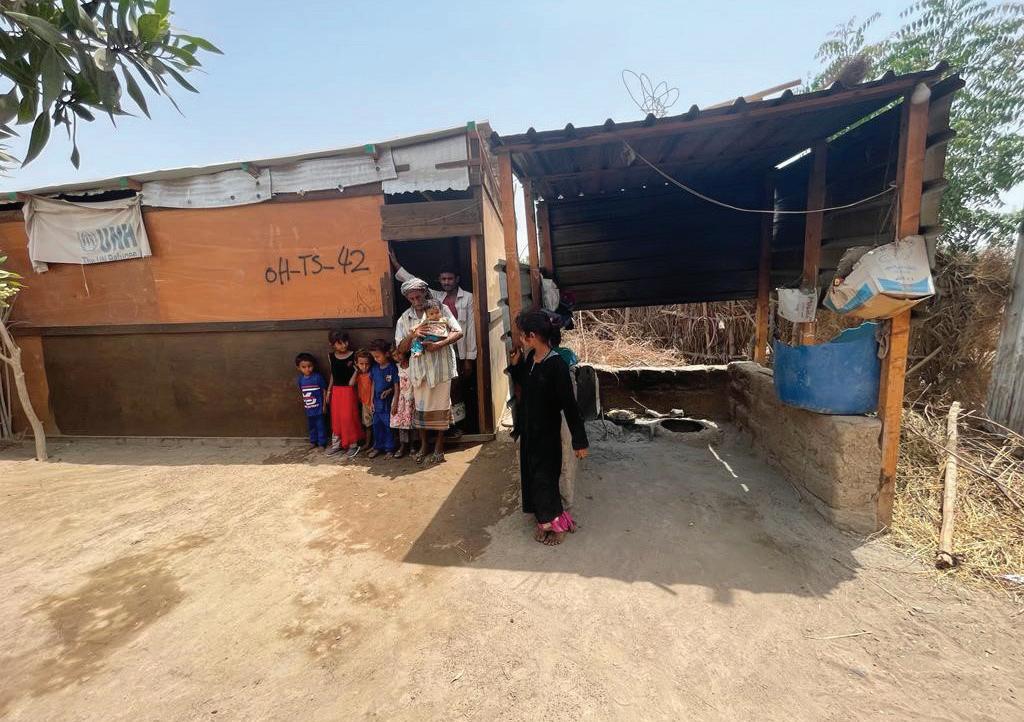
For those, like Qasim, who were forced to leave behind their official documents, DrC’s community centers have supported them to get these documents renewed through a referral system. These documents are crucial for his children and himself to access
essential services such as healthcare and education. They also enable internally displaced persons (IdPs) to engage in the livelihood activities of their communities and support their families.
However, Qasim’s wish for the future is simple, "memories of my past life in At Tuhayta, Al Hodeidah keep flashing back. I once had a house and a farm, where we cultivated fruits. I'm uncertain if such days will ever come back, but in this moment, my deepest desire is simply to live. I have no interest in commerce or property, I yearn for nothing more than existence," he said.
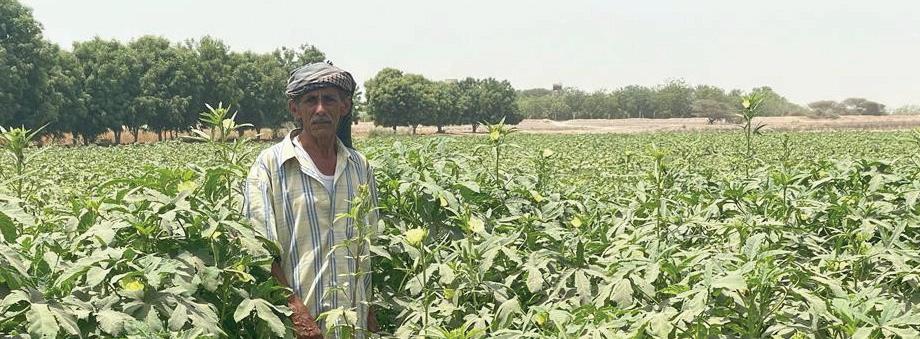
Qasim's story is just one of many that highlights the situation of IDPs in Yemen, which remains dire. The conflict has caused widespread displacement, food insecurity, and lack of access to basic services and left millions of Yemeni people in need of humanitarian assistance.
The Yemen Humanitarian Fund's support is crucial for organizations like DrC to continue providing lifesaving aid to those who need it most.
YHF CASH ASSISTANCE: SAVING LIVES AND EMPOWERING CHOICES
Relief and Development Peer Foundation (RDP)
Humanitarian needs persist among internally displaced people (IDPs), who were forced to flee their homes during the first years of dreadful conflict in Yemen.
“After the forcible displacement, we were surviving on one meal a day,” said Zainab, a 37-year-old mother of five children, living in an IdP site in As Sawadiyah district of Al Bayda Governorate in Yemen. In 2017, when the war escalated in all areas of Sa’dah Governorate, thousands of families including Zainab’s were coerced to leave their homes in search of safety and security.
Zainab and her children had to flee from Sa’dah to Al-Ghathmah Site, where they were settled in a makeshift and unfurnished tent. l ike many other IdP families going through displacement, the family was so anxious about how they would manage to survive with barely any food, medicine, or basic essentials like a roof over their heads.
Before fleeing her home, Zainab had worked as a farmworker for daily wages to afford the family's varying needs and to put food on the table. She suddenly found herself destitute the moment she moved to the IdP site, with no alternative source of income to buy food and medication for her children. However, this mother has never gave up fighting for her children. She wakes up every day to collect and sell plastic bottles, even for an inadequate amount of money, along with what IdP families receive from humanitarian organizations.
Yemen Humanitarian Fund (YHF) partnered with Relief and d evelopment Peer Foundation (R dP) to alleviate the food security crisis among internally displaced people and host communities.

In Al-Ghathmah Site, Zainab’s family was one of 180 households that benefited from the YHF-supported unconditional cash assistance within the r DP’s life-saving food security project for IDPs and host communities. The project provided unconditional cash assistance to 500 households, almost 3,500 people, including 740 women and 2,200 children, for six consecutive rounds in As Sawadiyah district of Al Bayda Governorate.
YHF-supported unconditional cash transfer interventions have allowed people in need to determine their priorities and allocate aid cash towards a variety of expenses, such as food, household goods, livelihood support, and repairs to their homes. Cash assistance has empowered internally displaced individuals to meet their unique and diverse needs with respect and dignity.
w ith continued support to the Yemen Humanitarian Fund and Yemen Response Plan, aid partners can reach vulnerable families like Zainab’s with humanitarian assistance, so they can survive and rebuild their lives.
